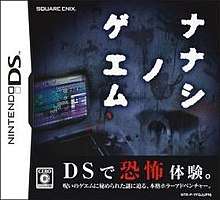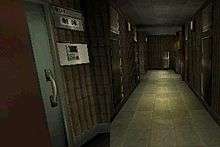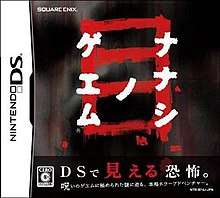Nanashi no Game
Nanashi no Game (ナナシ ノ ゲエム, Nanashi no Geemu, lit. "Nameless Game" or "The Game with No Name") is a first-person survival horror video game developed by Epics and published by Square Enix for the Nintendo DS. The game follows a university student who becomes cursed by the titular role-playing game, which causes people to die in seven days upon starting. It was released on July 3, 2008 in Japan.[2][3] A sequel, titled Nanashi no Game: Me, was later released on August 27, 2009 in Japan, followed by another sequel in 2012.
| Nanashi no Game | |
|---|---|
 Japanese box art[1] | |
| Developer(s) | Epics |
| Publisher(s) | [1] |
| Director(s) | Nobuhiko Tenkawa |
| Producer(s) | Seiichiro Tsuno Yosuke Tomita |
| Artist(s) | Arata Sakai |
| Composer(s) | Masayoshi Soken |
| Platform(s) | Nintendo DS |
| Release |
|
| Genre(s) | Survival horror |
| Mode(s) | Single-player |
Gameplay

Nanashi no Game involves two separate modes of play. Most of the game takes place in the real world, where the player navigates real-time 3D environments using the DS's D-Pad and Touch Screen. While exploring, the player must solve puzzles and reach locations. The player can switch to the TS Menu at any time, where they can play the cursed game, read e-mail messages, and load a previous save file. In many cases, an e-mail message or update to the cursed game will interrupt the player's exploration. In the cursed game, which only uses the top DS screen, the player controls a 2D 8-bit RPG that provides clues to the current situations and can, in some cases, advance the story.[4]
Partway into the game, the player will encounter Regrets (ルグレ, Rugure), zombie-like spirits that roam the area in exploration mode. If a Regret comes into contact with the player, it is game over.[5][6] Regrets take several roles in the game, from standing guard at stationary posts to actively chasing (or attempting to scare) the player. In some situations, the cursed game provides clues for bypassing Regrets in a given situation.[5][6]
Plot
An urban legend has been circulating about a nameless, cursed role-playing video game for the fictional Twin Screen (TS) handheld game system. According to the rumor, anyone who plays this "Cursed Game" (呪いのゲーム, Noroi no Game) and does not complete it within seven days will die.
The player assumes the role of a college student at Nanto University, Tokyo. The player has started playing the cursed game, sent to them by classmate Fumihito Odaka (尾高 文人, Odaka Fumihito), who has been absent recently. Riko Nagasawa (長沢 理子, Nagasawa Riko), Odaka's girlfriend requests that the player go to Odaka's apartment. The player obliges, but makes a horrific discovery: Odaka has mysteriously died of drowning, with his TS system in his hands.[7][8] The player also discovers that Odaka hadn't sent the game to the player, as he was trying to stop it from "spreading and killing others". The next day, a distressed Riko dies on the Nanto Express subway, having received the cursed game six days before the protagonist.[8]
On the player's third day, Nanto University professor Houki Ooyama (大山 法基, Ōyama Houki) calls the player to his office. An IT expert on digital information with an interest in folklore, Ooyama confirms that a "killer curse" is a very real possibility, and sees the nameless game as an opportunity to conduct research on its mysteries.[8] He first directs the player to investigate Jikyuu General Hospital (慈急総合病院, Jikyū Sōgō Byōin), the abandoned location of the cursed game's domain. Partway through, Ooyama has the player look for a medical chart for Shin Yutani (湯谷 紳, Yutani Shin), a man who died in a similar fashion to Odaka. The player soon discovers that they are being pursued by spirits devoid of eyes or mouth, and discovers Riko as one of them. Riko's "spirit" appears after the player obtains Yutani's chart and receives a disturbing game update, and chases them out of the hospital.[8]
On the fourth day, Professor Ooyama and the player learn that Yutani was the president of a video game company called Uta-Soft, located on the fourth floor of the Nakano Broadway shopping center; Ooyama directs the player there, warning them to avoid the spirits, which he dubs "Regrets", while exploring. Along the way, Ooyama sends the player information on Uta-Soft, including the fact that the company has gone bankrupt, with most of its workers missing and presumed dead. At the abandoned office, the player collects various pieces of information, including a plan for the unnamed game and an employee roster, before escaping the Regrets.[8]
On the fifth day, Ooyama finds that only one person from Uta-Soft is still alive: Ushio Ikuta (生田 潮, Ikuta Ushio), the creative director of the unnamed game. The player travels to the abandoned Ikuta residence, where they find a near-catatonic Ushio in the closet. Almost immediately after, a game update takes the player into a flashback of events inside the house. Yutani, constantly stressed from work and jealous of Ikuta's love for his family, brutally murdered his wife Tomoka while Ikuta was at work. Ikuta's daughter Asahi, who hated video games (as they kept Ikuta from spending time with the family), came home to find an indescribably bloody scene, with Yutani splattered in blood and grinning madly. Luckily, Asahi was able to escape the house before Yutani could catch her as well. After the vision ends, Ikuta utters Asahi's name, and gives the player her picture diary.[8]
On the sixth day, Ooyama explains to the player that after Tomoka's death, Ikuta continued to work on the cancelled game, angering Asahi into running away from home. From the information in the diary, Ooyama guesses that Asahi may have gone to the capeside Misaki Hotel (ミサキホテル, Misaki Hoteru); he directs the player there, telling them he would meet them there later. When the player finds Asahi's body there, she communicates to the player through the game, asking why they came for her despite her attempts to kill them, before vanishing. The player leaves the hotel to meet with Ooyama, but is forced to flee upon making a shocking discovery: Ooyama has been turned into a Regret (most likely from freezing to death). Asahi again communicates to the player, declaring that her actions were to avenge her mother, and that she will never forgive her father, video games, or even the player. Later, a delayed e-mail message from Ooyama asks the player what the drawing in Odaka's apartment stood for. Realizing that it was the Seven Capes Lighthouse (七支崎灯台, Nana Sasō saki tōdai) located nearby, the player heads there.[8]
On the seventh and last day, the player arrives at the lighthouse. There, they learn that Asahi is the true source of the game's curse, having committed suicide by jumping from the top of the lighthouse. The player then heads for the nearby cliff (depicted many times in the cursed game) to reach Asahi before daybreak, in 3 minutes. Along the way, they must speak to the now-harmless spirits of the curse, in reverse chronological order, through the cursed game. Ooyama's spirit explains that he became a Regret because he wanted to see what would happen if one received the game, but never played it. Having received the game one day before the player, that makes Ooyama another victim. Ooyama explains that he now understands Ikuta's reason for working on the nameless game: to show that video games can be used to show someone how much they love them. After talking with Riko, Odaka, and the three missing Uta-Soft employees, the player speaks to Yutani, the curse's first victim. Acknowledging that he was the reason the curse began (by murdering Asahi's mother), Yutani tells the player to speak with Asahi and help her realize what she had in terms of family and love.[8]
When the player communicates to Asahi, they show her the happy memories that she and her family shared. Suddenly, Tomoka's spirit appears through the game, telling Asahi that she is sad that her daughter had died, and also closed her heart. When Tomoka mentions Ikuta directly, the player finds Ikuta standing next to them in the real world, having been led here by Tomoka's spirit. He explains his good intentions for creating the game, and apologizes to Asahi. In the game, Asahi responds, saying "Papa!" (パパ!, lit. "Daddy!"); and the scene fades to white, before returning to the player, sitting at the cliff and very much alive. Ikuta, who notices the player, asks if they have met before; the player confirms this, before asking how the nameless game ends. Ikuta, taken aback by the player's interest, decides to complete the game's story to make amends to his family. Afterward, the game credits play, revealing the name of the nameless game: "Road to Sunrise".[8]
Endings
The game has two different endings, depending on whether the player obtained all of the special items found in the nameless game. If the player obtains every single item, they will unlock the good ending; otherwise, they will receive the bad ending.[8]
- Good Ending: after the nameless game fades to white, the player will see Asahi's spirit, now smiling with gratitude, before she passes on. The scene returns to the player, who bids her farewell, before Ikuta speaks to them. After the credits, the player receives a message from Asahi—"Thank you."—indicating that her curse has been broken.[8]
- Bad Ending: after the nameless game fades to white, the scene skips directly to the player, who expresses relief that the nightmare is finally over, before Ikuta speaks to them. After the credits, an on-screen message will say "Transfer Complete", implying that the curse has instead transferred to someone else.[8]
Development
The game's soundtrack was composed by Masayoshi Soken under the pseudonym "Luis Noma" (ルイーズ 野間, Ruīzu Noma), a name which in the game refers to the composer for the cursed game's soundtrack. On 7 July 2008, Square Enix released a five-track EP of music from Nanashi no Game titled Nanashi no Game Sound (ナナシ ノ ゲエム 音, Nanashi no Geemu On).
As of September 30, 2008, Nanashi no Game has sold 60,000 copies in Japan.[9] [10][11][12][13][14]
Sequels and spin-offs
| Nanash no Game: Me | |
|---|---|
 Cover art | |
| Developer(s) | Epics |
| Publisher(s) | Square Enix |
| Series | Nanashi no Game |
| Platform(s) | Nintendo DS |
| Release | |
| Genre(s) | Survival horror |
| Mode(s) | Single-player |
Nanashi no Game: Me (ナナシ ノ ゲエム 目, Nanashi no Geemu Me, lit. "Nameless Game: Eye") is a survival horror video game for the Nintendo DS, and the sequel to the original Nanashi no Game. It was developed by Epics, published by Square Enix, and released on August 27, 2009 in Japan.[17] The story follows an anthropology student from Nanto University, as he discovers two cursed games, an RPG and a platformer. The game's title refers to the protagonist's left eye, represented by the left screen of the DS when held sideways, which allows the player to see things left (and hidden) by the curse.[18][19][20][21] It sold 15,000 copies on the week of its release.[22]
Much like in the original, Nanashi no Game: Me involves two separate modes of play. Most of the game takes place in the real world, where the player navigates real-time 3D environments using the DS's D-Pad and Touch Screen. While exploring, the player must solve puzzles and reach locations. The player can switch to the TS Menu at any time, where they can play the cursed game, read e-mail messages, and load a previous save file. In many cases, an e-mail message or update to the cursed game will interrupt the player's exploration. In the cursed game, which only uses the top DS screen, the player controls a 2D 8-bit RPG that provides clues to the current situations and can, in some cases, advance the story.[4] In Nanashi no Game: Me, the player can now choose the locations they want to explore out of the two available for each day (for three days only). Each destination provides different experiences, including the Regrets the player will encounter.[18]
Two spin-off DSiWare titles, named Noroi no Game: Chi (ノロイ ノ ゲエム 血, Noroi no Gēmu Chi, lit. "Cursed Game: Blood") and Noroi no Game: Oku (ノロイ ノ ゲエム 獄, Noroi no Gēmu Oku, lit. "Cursed Game: Prison") respectively, have also been released on 9 September 2009.
Another sequel, Nanashi no Appli (ナナシ ノ 或プリ, Nanashi no Apuri, lit. "Nameless App"), was released on 26 January 2012 for iOS, and in February 2012 for Android.[23][24]
References
- "Nanashi no Game - Nintendo DS". IGN. Retrieved 26 February 2013.
- "Square Enix Tries Survival Horror". IGN.
- Spencer (2011-03-28). "Nanashi No Game Was Considered For North America, Focus Groups Killed It". Siliconera. Retrieved 2013-03-25.
- Spencer (26 June 2008). "Surviving Nanashi no Game's cursed game". Retrieved 23 May 2011.
- "Nanashi no Game - Nintendo DS". GameSpy. GameSpy. 2008-07-03. Archived from the original on 2008-05-13. Retrieved 2013-03-28.
- "ナナシ ノ ゲエム". Square-enix.co.jp. Square Enix. 2008. Retrieved 2013-04-09.
- Spencer (2008-06-26). "Surviving Nanashi no Game's cursed game". Siliconera. Retrieved 2013-04-09.
- Epics (3 June 2008). Nanashi no Game (Nintendo DS) (in Japanese). Square Enix.
- "Results Briefing Session: The First-Half of the Fiscal Year ending March 31, 2009" (PDF). Square-Enix.com. Retrieved 2008-12-26.
- "『ナナシ ノ ゲエム』を題材にしたホラーアトラクション"ナナシ ノ シタイ"をひと足さきに体験 - ファミ通.com". Famitsu.com. 2008-07-17. Retrieved 2013-06-07.
- "富士急ハイランドで「戦慄迷宮 ナナシ ノ シタイ」期間限定で登場 - 電撃オンライン". News.dengeki.com. 2008-06-17. Retrieved 2013-06-07.
- "富士急ハイランド「戦慄迷宮 ナナシ ノ シタイ」が期間延長決定 - 電撃オンライン". News.dengeki.com. 2008-09-30. Retrieved 2013-06-07.
- "20080625162833_080625senritsu_nanashi2.pdf" (PDF).
- プチたび取材班 (2008年7月18日 12:10). "速報/富士急ハイランドの『戦慄迷宮4.0ナナシ ノ シタイ』を公開直前に体験【取材班ブログ】旅行サイト『プチたび』". puchitabi.jp. Archived from the original on 2013-03-31. Retrieved 2013-06-07.
- "Famitsu Japanese Game Sales Ranking 6/30 - 7/6". Famitsu.
- Riley, Adam (10 September 2008). "Nanashi no Game Nintendo DS Nintendo Review". Cubed3.com. Retrieved 15 March 2013.
- "『ナナシ ノ ゲエム』公式サイトに異変!? - ファミ通.com". Famitsu.com. Famitsu. 2009-05-22. Retrieved 2013-04-09.
- "ナナシ ノ ゲエム 目". Square Enix. Retrieved 2013-03-25.
- Spencer (2009-09-08). "Nanashi no Game: Me: Open Your Eyes". Siliconera. Retrieved 2013-03-28.
- Spencer (May 29, 2009). "New Nanashi no Game Has A Cursed Platformer". Siliconera.com. Retrieved 2009-06-28.
- "ナナシ ノ ゲエム 目/ ファミ通.com". Famitsu.com. Famitsu. Retrieved 2013-04-09.
- "【ゲームソフト販売本数ランキング TOP30】集計期間:2009年8月31日〜9月6日 - ファミ通.com". Famitsu.com. Famitsu. Retrieved 2013-03-25.
- "『ナナシ ノ 或プリ』あの『ナナシノゲエム』シリーズ最新作がiOSで配信 現実とリンクする恐怖を体感せよ! - ファミ通App". Famitsu.com. 26 January 2012. Retrieved 27 January 2012.
- "774 Deaths". IGN. IGN. Retrieved 6 March 2013.
External links
- Official website (in Japanese)